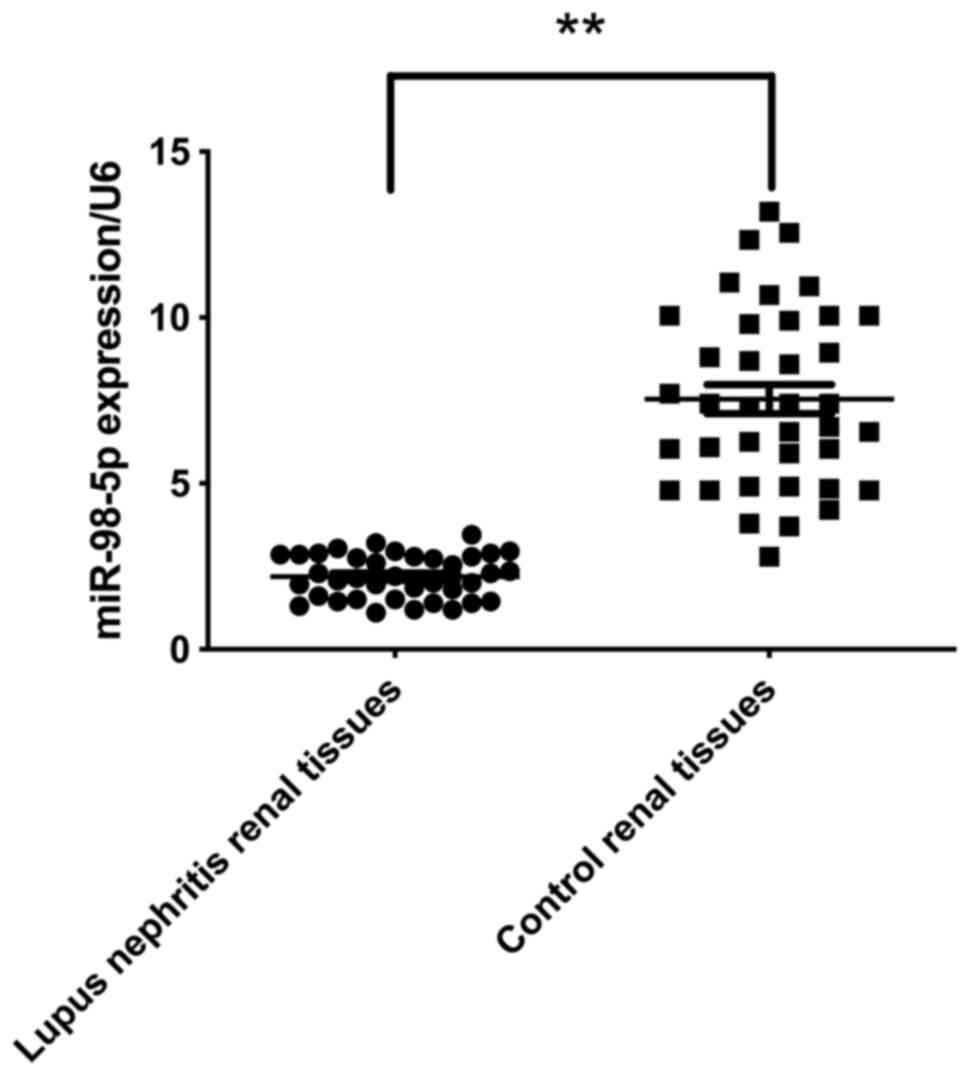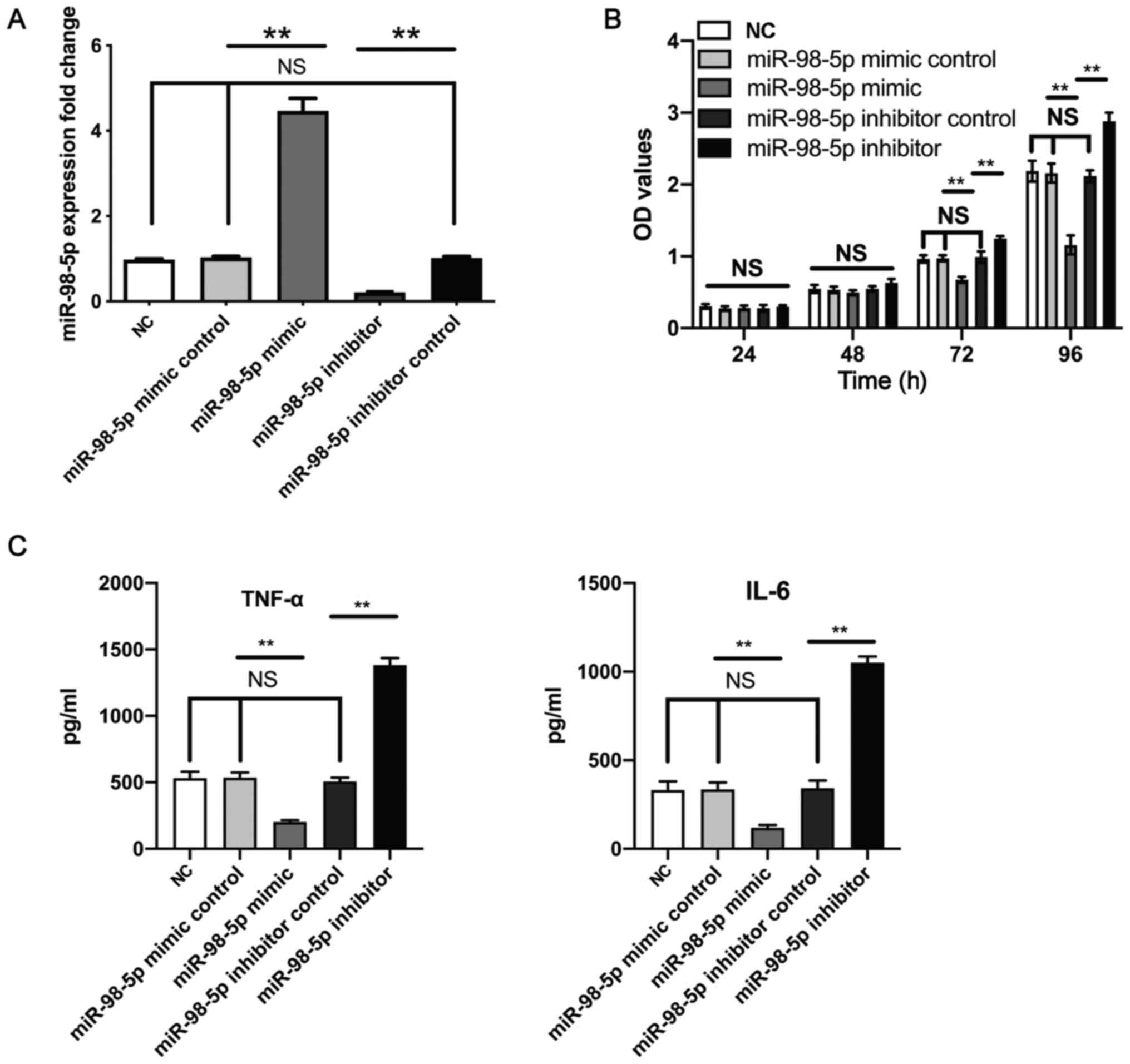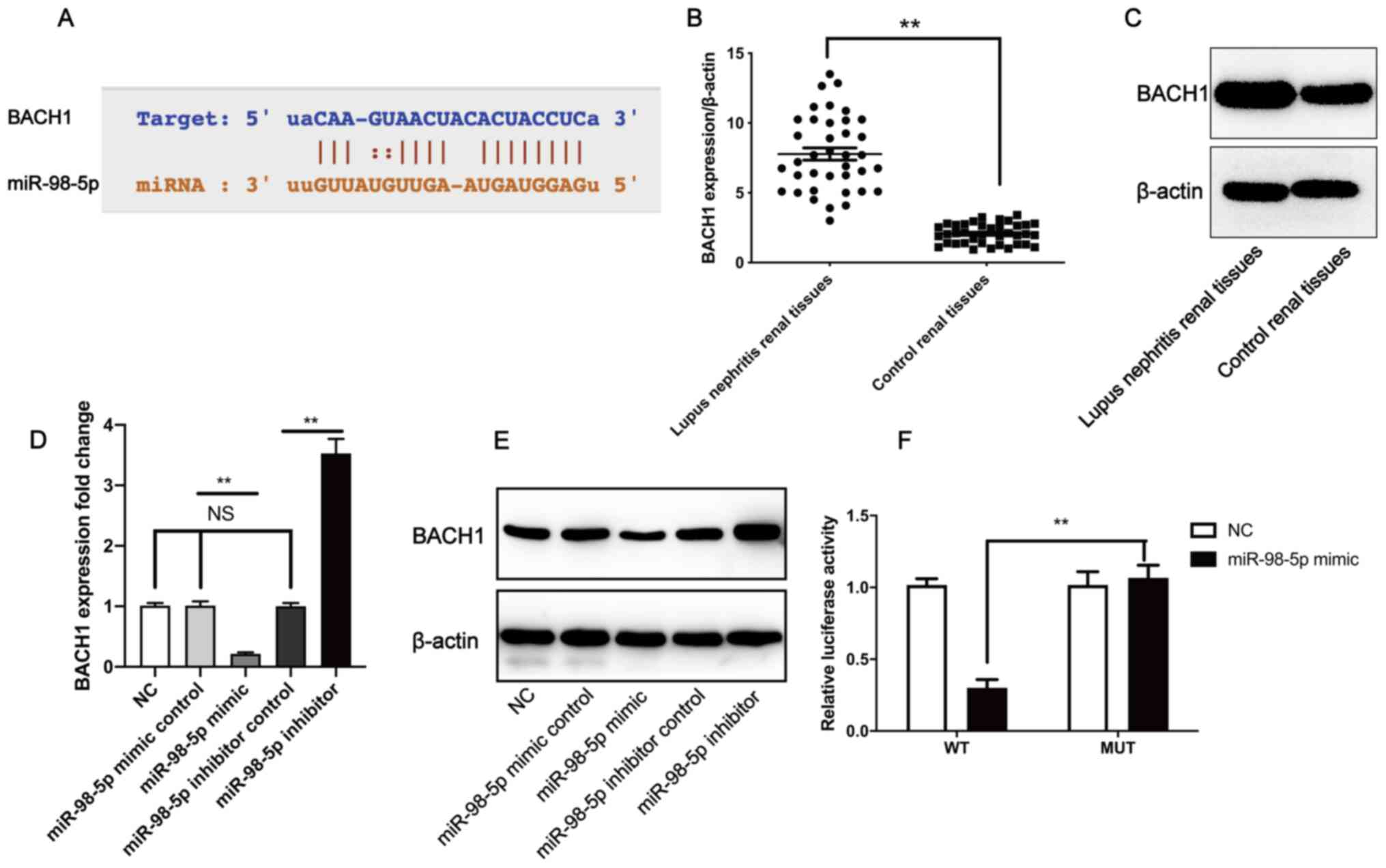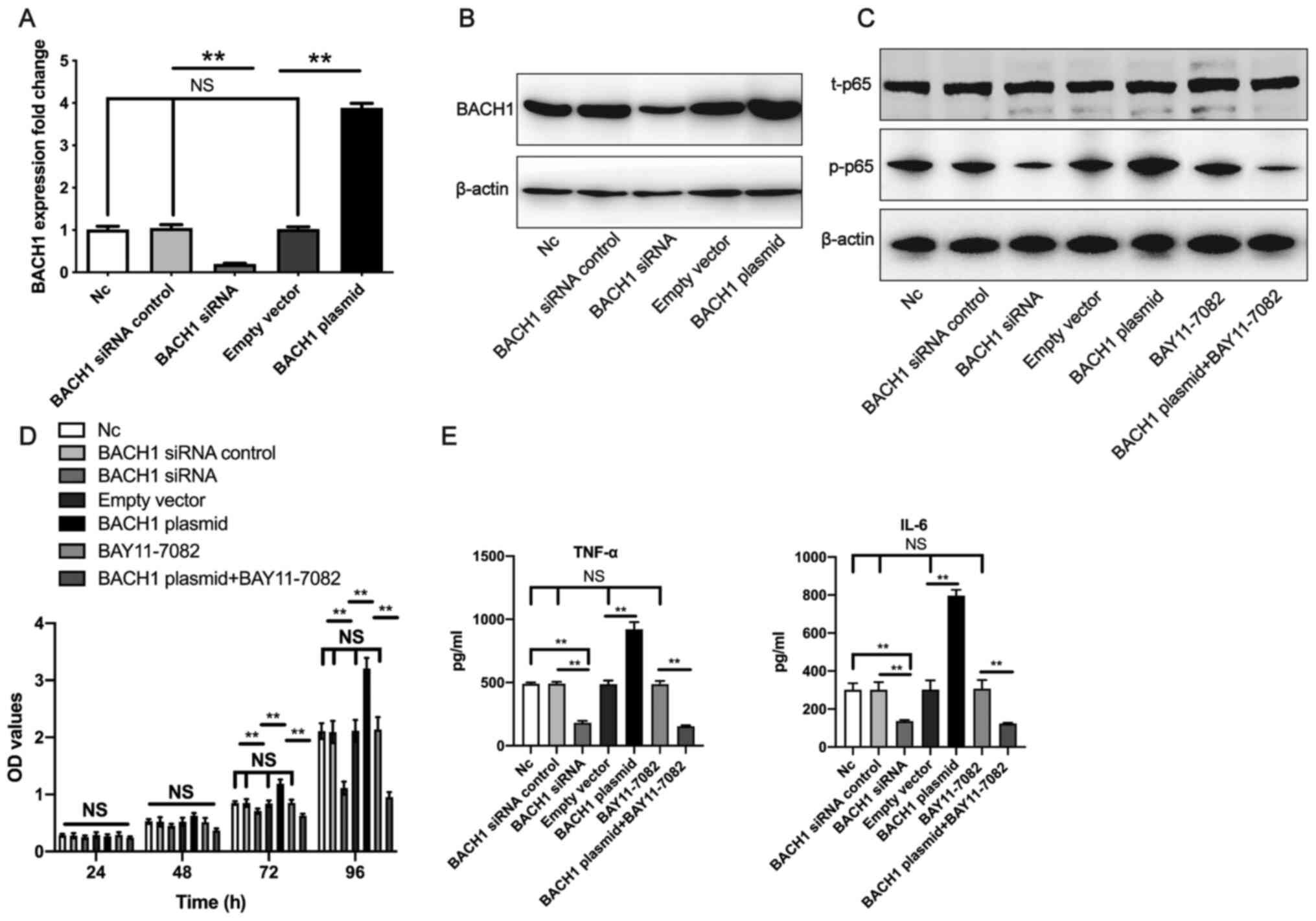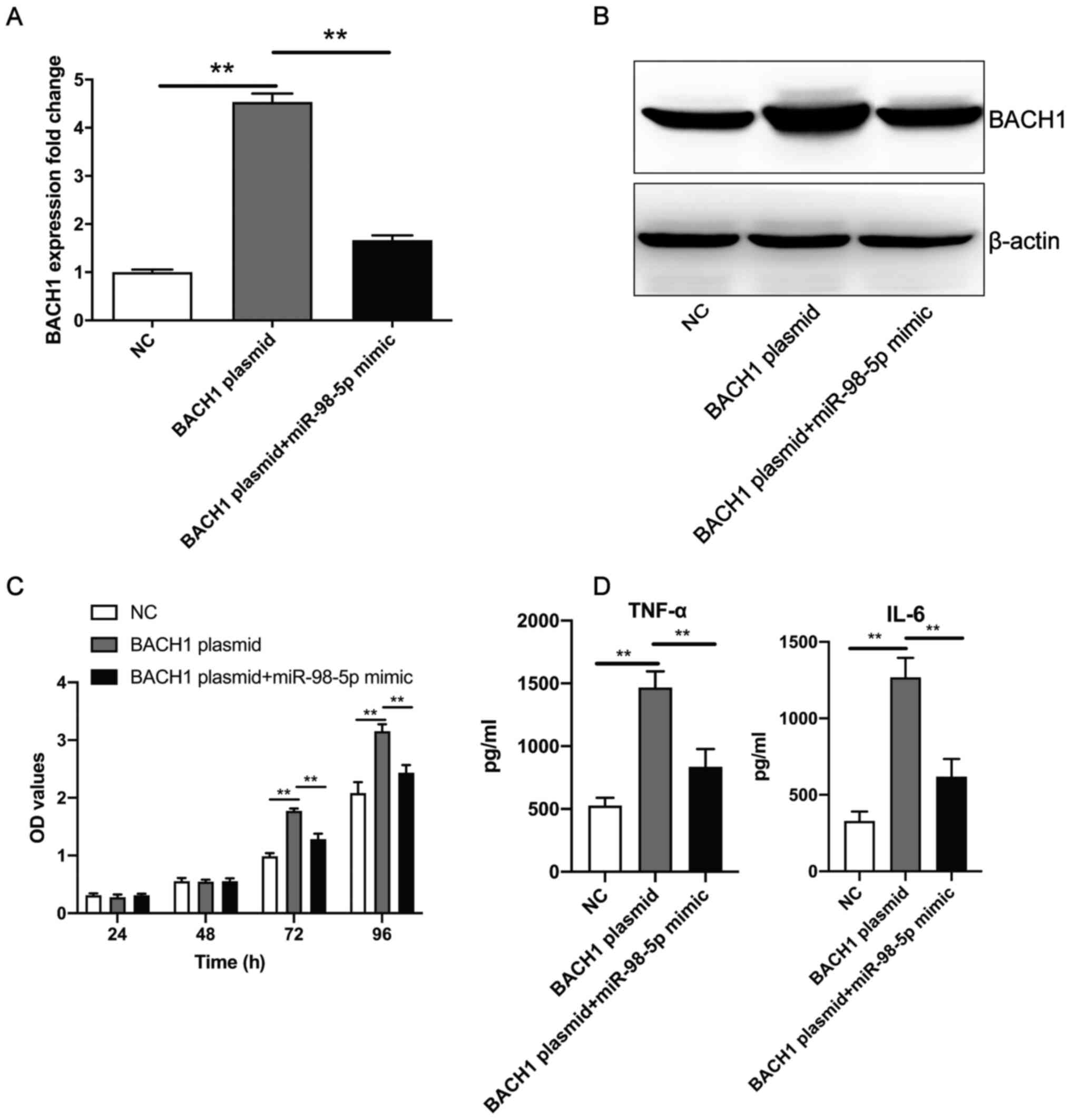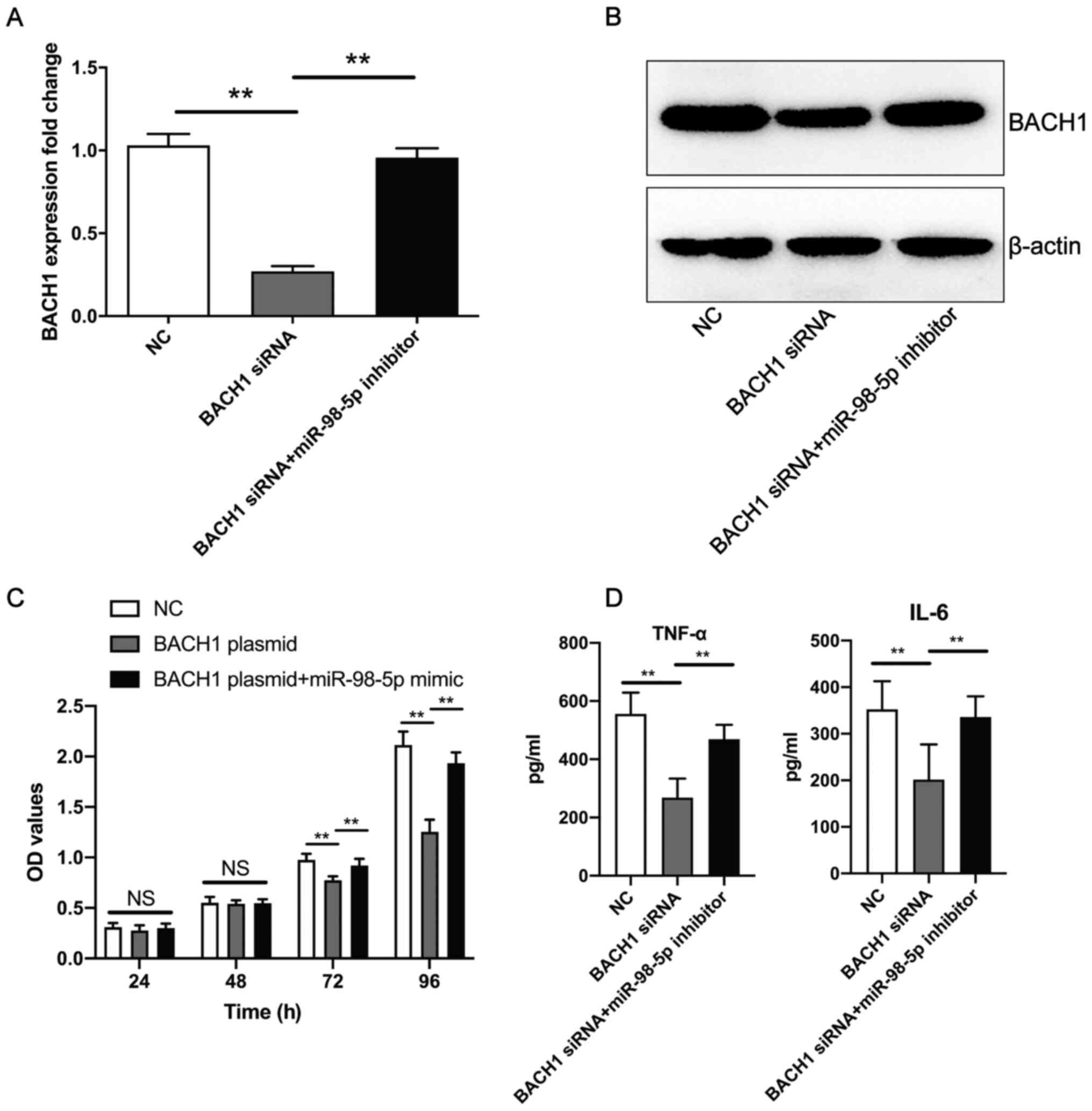MicroRNA-98-5p inhibits human mesangial cell proliferation and TNF-α and IL‑6 secretion by targeting BTB and CNC homology 1
- Authors:
- Published online on: October 12, 2021 https://doi.org/10.3892/etm.2021.10871
- Article Number: 1436
-
Copyright: © Du et al. This is an open access article distributed under the terms of Creative Commons Attribution License.
Abstract
Introduction
Systemic lupus erythematosus (SLE) is a common autoimmune disease that can involve multiple organs and systems (1). One of the most common complications of SLE is lupus nephritis (LN) (2). The incidence rate of LN among different nationalities is statistically significant, with a low cumulative incidence rate of LN in Caucasian individuals (14% of patients with SLE), compared with a relatively high incidence rate among Asians (55% of patients with SLE), Africans (51% of patients with SLE) and Hispanics (43% of patients with SLE) (2).
The main histological features of LN include mesangial cell proliferation, followed by increased extracellular matrix and inflammatory cell infiltration, as well as glomerulosclerosis and renal interstitial fibrosis at the end stage (3). Based on the disease severity, 10-30% of patients with LN will progress to end-stage renal disease (4). Although LN was discovered centuries ago, its pathogenesis remains unclear.
Mesangial cells represent a type of glomerular proper cell situated between the capillary loops of the glomerulus, adjacent to endothelial cells or the basement membrane, that exhibit an irregular shape (5). Cellular processes can reach deep between endothelial cells and the basement membrane, or extend into the capillary cavity through endothelial cells. Moreover, mesangial cells have specialized functions, including cytokine production, cell matrix secretion, glomerular capillary network support, phagocytosis and the clearance of macromolecular substances, which are important for the maintenance of the normal glomeruli structure and function (6). The excessive proliferation of mesangial cells is one of the first pathological changes that occur in LN (7). In particular, the excessive proliferation of mesangial cells can stimulate the release additional inflammatory factors, promote extracellular matrix secretion, aggravate inflammation and cause glomerulosclerosis (8). Therefore, the elucidation of the genes associated with mesangial cell proliferation is required to further reveal the pathological mechanism of LN and develop novel therapeutic methods.
MicroRNAs (miRNAs/miRs) are a group of non-coding short RNAs ranging from 19-25 nucleotides in length that are found in eukaryotes (9). Moreover, miRNAs exhibit highly conserved genetic characteristics and can regulate gene expression at both the transcriptional and post-transcriptional level. miRNAs have been revealed to be involved in a variety of mammalian pathophysiological processes, such as intracellular signal response, cell differentiation, cell proliferation and apoptosis (10). Therefore, the identification of miRNAs that can regulate the proliferation or apoptosis of glomerular mesangial cells has notable clinical significance to further reveal the pathological mechanism of LN that could be used to develop strategies to delay the onset of LN.
miR-98-5p is located on the X chromosome, is a member of the let-7/miR-98-5p family with highly conserved evolution and has a mature sequence that consists of 22 bases (11). Recent studies have revealed that miR-98-5p is involved in the pathogenesis of SLE. Yuan et al (12) revealed that miR-98-5p could ameliorate STAT3-mediated cellular proliferation and inflammatory cytokine production in patients with SLE via its target gene, IL-6. Another study conducted by Xie et al (13) demonstrated that miR-98-5p downregulation induced apoptosis by modulating the Fas-mediated apoptotic signaling pathway in SLE CD4+ T cells. Since miR-98-5p is involved in SLE pathogenesis, the present study hypothesized that miR-98-5p may also be involved in LN pathogenesis. The present study therefore aimed to elucidate the effect of miR-98-5p on mesangial cell proliferation and its specific mechanism in order to provide novel strategies for the treatment of LN.
Materials and methods
Patients
A total of 38 patients (female, 21; male, 17; age, 49-66 years) with LN were enrolled between January 2015 and January 2020 from the Department of Rheumatology and Immunology at the Affiliated Hospital of Hebei University (Hebei, China). The classification of LN was based on the International Society of Nephrology/Renal Pathology Society criteria (14), and the LN diagnosis was confirmed by a pathologist which was independent from the study. The exclusion criteria were as follows: i) Other rheumatic immune diseases, tumors, or infectious diseases; and ii) pregnant women. LN renal tissue was obtained during a renal biopsy. All patients signed informed consent prior to surgery. As a control group, carcinoma-adjacent renal tissues (5 cm away from tumor tissues) were obtained from 38 patients (female, 18; male, 20; age, 48-69 years) who underwent nephrectomy for renal cell carcinoma, between March 2017 and October 2019 at the Department of Urology, at the Affiliated Hospital of Hebei University. The exclusion criteria were as follows: i) Other rheumatic immune diseases, tumors, or infectious diseases; ii) pregnant women; and iii) active malignancies other than renal cell carcinoma. Written informed consent was obtained from all patients prior to surgery. The present study was approved by The Institute of Medical Ethics Committee of Affiliated Hospital of Hebei University (approval no. HBU201401221027).
Cell culture
A human mesangial cell line IP15 was purchased from the Cell Resource Center, Shanghai Institutes for Biological Sciences. The cells were cultured in DMEM (Gibco; Thermo Fisher Scientific, Inc.) supplemented with 10% FBS (Hyclone; Cytiva), 100 IU/ml penicillin (Gibco; Thermo Fisher Scientific, Inc.) and 100 mg/ml streptomycin (Gibco; Thermo Fisher Scientific, Inc.). All cells were maintained in a humidified atmosphere containing 5% CO2 at 37˚C. The NF-κB inhibitor BAY11-7082 (Selleck Chemicals; cat. no. S2913) (5 µM) was added to the medium at 37˚C 1 h after transfection for 48 h.
Cell transfection
The negative control (5'-UCGCUUGG UGCAGGUCGGG-3'), miR-98-5p mimic (5'-UGAGG UAGUAAGUUGUAUUGUU-3'), miR-98-5p inhibitor (5'-AAAUAUGCUGUAUGUCAUGUGUU-3'), BTB and CNC homology 1 (BACH1) small interfering RNA (siRNA; 5'-GGAGGTGGATGTGAAAGAT-3'), miR-98-5p mimic control (5'-UCACAACCUCCUAGAAAGAGUAGA-3'), miR-98-5p inhibitor control (5'-GUCCAGUGAAUUCC CAG-3') and BACH1 siRNA control (5'-GGCCTTGCGAT AGCGTAGC-3'), as well as the BACH1-overexpression plasmid and empty vector were designed and synthesized by Shanghai GenePharma Co., Ltd. Human mesangial IP15 cells were seeded into 24-well plates at a density of 5x105 cells/well and incubated overnight at 37˚C. The negative control (NC) (20 µM), miR-98-5p mimic control (20 µM), miR-98-5p mimic (20 µM), miR-98-5p inhibitor control (20 µM), miR-98-5p inhibitor (20 µM), BACH1 siRNA control (20 µM), BACH1 siRNA (20 µM), empty vector (1,000 ng) and BACH1-overexpression plasmid (1,000 ng) were transfected into human mesangial cells using Lipofectamine® 2000 reagent (Invitrogen; Thermo Fisher Scientific, Inc.), according to the manufacturer's protocol at 37˚C for 48 h. Total RNA and protein were extracted from the human mesangial cells at 48 h post-transfection for reverse transcription-quantitative PCR (RT-qPCR) and western blotting, respectively.
Cell Counting Kit-8 (CCK-8) assay
A CCK-8 kit (Dojindo Molecular Technologies, Inc.) was used to evaluate the proliferative ability of human mesangial cells. Human mesangial cells were seeded into 96-well plates at a density of 2x103 cells/well and incubated for 24, 48, 72 or 96 h at 37˚C. Following this incubation, 20 µl of 10% CCK-8 reagent was added per well and incubated at 37˚C for 2 h. The optical density was measured at 450 nm using an Enzyme Immunoassay Analyzer (Bio-Rad Laboratories, Inc.).
ELISA
Human mesangial cells were transfected with the miR-98-5p mimic, miR-98-5p mimic control, miR-98-5p inhibitor or miR-98-5p inhibitor control for 48 h. The culture supernatant was collected and the concentrations of IL-1β (cat. no. DLB50) and TNF-α (cat. no. DTA00D) were detected using commercial ELISA kits (R&D Systems, Inc.) in accordance with the manufacturer's instructions. The optical density at 450 nm was measured using an ELISA reader (Molecular Devices, LLC).
Reverse transcription-quantitative PCR (RT-qPCR)
RT-qPCR analysis was performed as previously described (15). Total RNA was extracted from renal tissues or transfected IP15 cells using TRIzol® reagent (Invitrogen; Thermo Fisher Scientific, Inc.) in accordance with the manufacturer's protocol. Reverse transcription was performed using a PrimeScript™ RT reagent kit (for BACH1 and β-actin; Takara Bio, Inc.) and an Mir-X miRNA RT-qPCR TB Green® kit (for miR-98-5p and U6; Takara Bio, Inc.) based on the manufacturer's instructions. Quantitative PCR was performed using TB Green® Premix Ex Taq™ II (Tli RNaseH Plus; Takara Bio, Inc.) in accordance with the manufacturer's instructions with a StepOnePlus Real-time PCR System (Thermo Fisher Scientific, Inc.). The thermocycling conditions were as follows: Initial denaturation at 95˚C for 30 sec, followed by 40 cycles of 95˚C for 5 sec and 60˚C for 31 sec. BACH1 forward, 5'-GCCCGTATGCTTGTGTGATT-3' and reverse, 5'-CGTGAGAGCGAAATTATCCG-3'; β-actin forward, 5'-CACCCACACTGTGCCCATCT-3' and reverse, 5'-GAACCGCTCATTGCCAATGG-3'; miR-98-5p forward, 5'-TGAGGTAGTAAGTTGTATTGTT-3' and reverse, 5'-GTGCAGGGTCCGAGGT-3'; and U6 forward, 5'-GCTTCGGCAGCACATATACTAAAAT-3' and reverse, 5'-CGCTTCACGAAT TTGCGTGTCAT-3'. All reactions were performed in triplicate. Relative expression levels were quantified using the 2-∆∆Cq method (16).
Western blotting
Total protein was extracted from renal tissues or transfected IP15 cells using RIPA lysis buffer (Beyotime Institute of Biotechnology, Cat. No. P0013B) according to the manufacturer's protocol. The BCA Protein assay kit (Beyotime Institute of Biotechnology) was used to measure the protein concentration. Total protein (60 µg/lane) was quantified and separated via 10% SDS-PAGE. The separated proteins were subsequently transferred onto PVDF membranes and blocked with 5% skimmed milk for 1 h at room temperature. The membranes were then incubated with the following primary antibodies in 5% fat-free milk overnight at 4˚C: Anti-BACH1 (cat. no. PA5-103060; 1:1,000; Invitrogen; Thermo Fisher Scientific, Inc.) and anti-β-actin (cat. no. ab8227; 1:1,000; Abcam). Following incubation with the primary antibody, membranes were washed three times in TBS-Tween (0.5% Tween) and incubated with an anti-mouse horseradish peroxidase-conjugated secondary antibody (cat. no. ab7090; 1:5,000; Abcam) for 1 h at room temperature. Protein bands were visualized using the enhanced chemiluminescence reagent (Pierce; Thermo Fisher Scientific, Inc.) and visualized on an iBright FL1500 imaging system (Invitrogen; Thermo Fisher Scientific, Inc.).
Dual luciferase reporter assay
StarBase 3.0 (http://starbase.sysu.edu.cn/) was used to predict whether miR-98-5p could directly bind to BACH1 mRNA. Subsequently, wild-type (WT) or mutant (MUT) BACH1, which contained miR-98-5p binding sites, were cloned into pmirGLO reporter vectors (Promega Corporation) to generate pmirGLO-BACH1-WT and pmirGLO-BACH1-MUT vectors, respectively, using a site-directed mutagenesis kit (cat. no. 200518; Agilent Technologies, Inc.). Subsequently, human mesangial cells were seeded into 24-well plates at a density of 5x105 cells/well until they reached 70% confluence. The cells were subsequently co-transfected with synthesized reporter vectors (0.8 µg), an miR-98-5p mimic (0.8 µg) or miR-98-5p mimic control (0.8 µg) using Lipofectamine 2000 reagent. Following a 48 h transfection at 37˚C, the level of Renilla luciferase activity was measured using a Dual-Luciferase Reporter Assay system (Promega Corporation) according to the manufacturer's protocol.
Statistical analysis
Statistical analysis was performed using SPSS version 19 software (IBM Corp.) and the data are presented as the mean ± standard deviation (unless otherwise shown). Statistical differences between groups were determined using a paired Student's t-test or a one-way ANOVA followed by a Tukey's post hoc test. P<0.05 was considered to indicate a statistically significant difference.
Results
miR-98-5p expression is downregulated in LN renal tissue
The levels of miR-98-5p expression in LN and control renal tissues were analyzed using RT-qPCR. The level of miR-98-5p expression was significantly downregulated in the LN renal tissues compared with control renal tissues (Fig. 1). This result suggests that miR-98-5p inhibited LN.
miR-98-5p inhibits the proliferation of human mesangial cells and the secretion of TNF-α and IL-6
Human mesangial cells were transfected with either a miR-98-5p mimic or miR-98-5p inhibitor. Transfection with the miR-98-5p mimic significantly upregulated the expression level of miR-98-5p compared with the miR-98-5p mimic control group, whereas transfection with the miR-98-5p inhibitor significantly downregulated the level of miR-98-5p expression compared with the miR-98-5p inhibitor control (Fig. 2A). The effects of miR-98-5p on the proliferation of human mesangial cells was investigated using a CCK-8 assay. The results of the CCK-8 proliferation assay revealed that, after 72 h, transfection with the miR-98-5p mimic significantly inhibited the proliferation of human mesangial cells compared with the mimic control; whereas transfection with the miR-98-5p inhibitor significantly increased the proliferation of human mesangial cells compared with that of the inhibitor control group (Fig. 2B). The results of the ELISA revealed no significant differences in cytokine secretion between the NC, miR-98-5p mimic control and miR-98-5p inhibitor control groups. Furthermore, compared with miR-98-5p mimic control, the miR-98-5p mimic significantly inhibited the secretion of TNF-α and IL-6. Whereas, compared with the miR-98-5p inhibitor control, the miR-98-5p inhibitor significantly promoted the secretion of TNF-α and IL-6 (Fig. 2C). These results suggest that miR-98-5p inhibited the proliferation and the inflammatory factors secretion of human mesangial cells.
miR-98-5p downregulates the expression level of BACH1 by directly targeting BACH1
To determine the downstream targets of miR-98-5p, a bioinformatics analysis was performed using StarBase 3.0. BACH1 was identified as a putative miR-98-5p target gene (Fig. 3A. Furthermore, BACH1 gene (Fig. 3B) and protein expression levels (Fig. 3C) in LN tissues were significantly higher compared with control renal tissues. RT-qPCR revealed that, compared with the mimic control group, transfection with the miR-98-5p mimic significantly downregulated the expression level of BACH1, whereas transfection with the miR-98-5p inhibitor significantly upregulated the expression level of BACH1 in human mesangial cells when compared with the miR-98-5p inhibitor control (Fig. 3D). The western blotting results confirmed those of RT-qPCR (Fig. 3E). To validate whether miR-98-5p directly targeted BACH1, dual luciferase reporter assays were performed. The relative luciferase activity was significantly different between the MUT plasmid + miR-98-5p mimic group and WT plasmids + miR-98-5p mimic group (Fig. 3F). These results indicate that miR-98-5p may downregulate the level of BACH1 expression by directly targeting the BACH1 3'-untranslated region (UTR). These results suggest that miR-98-5p directly inhibited the expression of BACH1.
BACH1 promotes human mesangial cell proliferation and the secretion of TNF-α and IL-6 through NF-κB
To further elucidate the role of BACH1, the present study overexpressed or knocked-down BACH1 in human mesangial cells. The knockdown of BACH1 using siRNA was confirmed to significantly downregulate BACH1 expression compared with the BACH1 siRNA control. Furthermore, the BACH1-overexpression plasmid significantly upregulated the level of BACH1 expression compared with the empty vector in human mesangial cells (Fig. 4A and B). According to western blotting, transfection with the BACH1 siRNA decreased p-p65 protein levels compared with the NC group, whereas the BACH1-overexpression plasmid increased the level of p-p65 protein. Moreover, the BACH1-overexpression plasmid + BAY11-7082 (an inhibitor of NF-κB, 5 µM) group displayed a lower p-p65 protein expression level compared with the BACH1-overexpression plasmid group (Fig. 4C). CCK-8 and ELISA assays were performed to investigate the effects of BACH1 overexpression and knockdown on cell proliferation and the secretion of TNF-α and IL-6 by human mesangial cells. After 72 h, treatment with the BACH1-overexpression plasmid significantly promoted human mesangial cell proliferation compared with the NC. However, treatment with the BACH1-overexpression plasmid and BAY11-7082 significantly inhibited human mesangial cell proliferation compared with the BAY11-7082 control group. Treatment with BACH1 siRNA significantly inhibited human mesangial cell proliferation compared with the BACH1 siRNA control group after 72 h (Fig. 4D). The BACH1-overexpression plasmid significantly promoted human mesangial cell secretion of TNF-α and IL-6 compared with the empty vector; while treatment with the BACH1-overexpression plasmid and BAY11-7082 inhibited human mesangial cell secretion of TNF-α and IL-6 compared with the BAY11-7082 control group. In addition, compared with BACH1 siRNA control, BACH1 siRNA inhibited human mesangial cell secretion of TNF-α and IL-6 (Fig. 4E). These results suggest that BACH1 promoted the proliferation and inflammatory factor secretion of human mesangial cells.
miR-98-5p mimic inhibits the BACH1-overexpression-induced increase of human mesangial cell proliferation and the secretion of TNF-α and IL-6
The aforementioned experiments revealed that the overexpression of BACH1 promoted human mesangial cell proliferation and the secretion of TNF-α and IL-6. Compared with BACH1-overexpression plasmid transfection, co-transfection with the miR-98-5p mimic and BACH1-overexpression plasmid resulted in the significant downregulation of BACH1 expression levels at both the mRNA (Fig. 5A) and protein (Fig. 5B) level. In addition, after 72 h, the co-transfection of the miR-98-5p mimic and BACH1-overexpression plasmid significantly inhibited human mesangial cell proliferation and secretion of TNF-α and IL-6 when compared with transfection of the BACH1-overexpression plasmid alone (Fig. 5C and D). These results suggest that miR-98-5p mimics reversed the BACH1-overexpression-induced increase of human mesangial cell proliferation and the secretion of inflammatory factors.
miR-98-5p inhibitor promotes the BACH1 siRNA-induced decrease in human mesangial cell proliferation and the secretion of TNF-α and IL-6
Co-transfection of the miR-98-5p inhibitor and BACH1 siRNA resulted in a significant upregulation of BACH1 expression at the mRNA (Fig. 6A) and protein (Fig. 6B) level in human mesangial cells compared with BACH1 siRNA transfection. Furthermore, compared with BACH1 overexpression plasmid transfection, the co-transfection of the BACH1 overexpression plasmid + miR-98-5p mimic promoted human mesangial cell proliferation (Fig. 6C), as well as the secretion of TNF-α and IL-6 (Fig. 6D) induced by BACH1 siRNA. These results suggest that miR-98-5p inhibitor reversed the BACH1 siRNA-induced decrease in human mesangial cell proliferation and the secretion of inflammatory factors.
Discussion
miRNAs have been reported to play a variety of important regulatory roles, including cell development, differentiation and proliferation, and a single miRNA can have multiple regulatory target genes (17). The relationship between miRNA and LN has been studied. For example, miR-124 serves as a novel diagnostic marker in human LN and can inhibit the proliferation and inflammation of renal mesangial cells by targeting TNF receptor-associated factor 6(18). However, to the best of our knowledge, the relationship between miR-98-5p and LN yet to be fully elucidated.
Previous research has highlighted the importance of miR-98-5p in several diseases; for example, miR-98-5p has been reported to protect cardiomyocytes from DOX-induced injury through regulation of the caspase-8-dependent Fas/RIP3 pathway (19). Another study demonstrated that miR-98-5p inhibits hepatic stellate cell activation and attenuates liver fibrosis by regulating hepatic leukemia factor expression (20). Additionally, the diminution of miR-98-5p has been demonstrated to alleviate renal fibrosis in diabetic nephropathy by elevating E3 ubiquitin-protein ligase NEDD4-like and inactivating the TGF-β/Smad2/3 pathway (21). Furthermore, miR-98-5p was reported to ameliorate oxygen-glucose deprivation/reoxygenation-induced neuronal injury by inhibiting BACH1(22). However, to the best of our knowledge, the relationship between miR-98-5p expression levels and patients with LN has not yet been reported. The results of the present study demonstrated that the expression levels of miR-98-5p were downregulated in LN renal tissues compared with control renal tissues. This suggested that miR-98-5p may be associated with LN.
The current study also indicated that the miR-98-5p mimic inhibited human mesangial cell proliferation, while the miR-98-5p inhibitor promoted the same process. Moreover, miRNAs modulate the expression levels of their target genes by targeting the 3'-UTRs of mRNA, with ~2/3 of human mRNAs being regulated by miRNAs in this manner (23). According to bioinformatics predictions, the present study hypothesized that miR-98-5p may affect the biological behavior of human mesangial cells, at least in part, by targeting BACH1 mRNA to regulate the expression levels of BACH1.
BACH1 is a heme binding protein composed of 739 amino acids with a molecular weight of 81 kDa, constituting the relationship between heme content, redox and transcription (24). BACH1 plays a key role in the physiological regulation of oxidative stress by inhibiting its important target, heme oxygenase 1(24). In addition, BACH1 is widely expressed in human tissues (25). Moreover, certain studies have demonstrated that BACH1 is closely associated with LN. For example, the study by Kishimoto et al (26) suggested that dysregulated M2-like macrophages play a proinflammatory role in LN, and that BACH1 represents a potential therapeutic target that can restore the anti-inflammatory properties of M2 macrophages. Furthermore, altered B cell subsets and cellular signatures of BACH1 may be associated with distinct patient phenotypes associated with the risk of LN relapse (27).
In the present study, the relative luciferase activity of the WT plasmid + miR-98-5p mimic group was lower compared with the NC and WT plasmid groups. The results of the dual luciferase reporter assay suggested that miR-98-5p could directly inhibit the expression of BACH1. Moreover, the present study revealed high levels of BACH1 expression in LN renal tissue compared with control tissues. BACH1-overexpression also promoted human mesangial cell proliferation, as well as the secretion of TNF-α and IL-6.
Further results of the present study showed that BACH1 increased the p-NF-κB level, and that cell proliferation and inflammatory factor secretion were inhibited by an NF-κB inhibitor. These results revealed that BACH1 promoted cell proliferation and inflammatory factor secretion through NF-κB. NF-κB is an important signal pathway that promotes LN, including promoting mesangial cell proliferation (28) and promoting the secretion of inflammatory factors (29).
However, the study was only a preliminary in vitro investigation on the role of miR-98-5p in human mesangial cells; the relationship between miR-98-5p and LN could not be confirmed. Furthermore, the internal environment is more complex, and this in vitro study could not represent the true situation in vivo. In the future, animal models should be used to investigate the relationship between miR-98-5p and LN.
In conclusion, the results of the present study indicated that the expression of miR-98-5p may be significantly downregulated in human LN renal tissue. Mechanistically, miR-98-5p-overexpression suppressed the proliferation of human mesangial cells by targeting BACH1. Overall, these data indicated that miR-98-5p and BACH1 may represent novel therapeutic strategies for LN.
Acknowledgements
Not applicable.
Funding
No funding was received.
Availability of data and materials
The datasets used and/or analyzed during the current study are available from the corresponding author on reasonable request.
Authors' contributions
YD, JL and YJ made substantial contributions to the conception and design of the study, as well as drafted and revised the manuscript for important intellectual content. YD, JL, XS and YJ acquired the data, and performed data analysis and interpretation. YD and YJ confirm the authenticity of all the raw data. All authors have read and approved the final manuscript and agree to be accountable for the accuracy and integrity of the study.
Ethics approval and consent to participate
The present study was approved by The Institute of Medical Ethics Committee of Affiliated Hospital of Hebei University (approval no. HBU201401221027; Hebei, China). Written informed consent was obtained from all patients prior to surgery.
Patient consent for publication
Not applicable.
Competing interests
The authors declare that they have no competing interests.
References
|
Talotta R, Atzeni F and Laska MJ: Therapeutic peptides for the treatment of systemic lupus erythematosus: A place in therapy. Expert Opin Investig Drugs. 29:845–867. 2020.PubMed/NCBI View Article : Google Scholar | |
|
Ramanujam M, Steffgen J, Visvanathan S, Mohan C, Fine JS and Putterman C: Phoenix from the flames: Rediscovering the role of the CD40-CD40L pathway in systemic lupus erythematosus and lupus nephritis. Autoimmun Rev. 19(102668)2020.PubMed/NCBI View Article : Google Scholar | |
|
Wang SF, Chen YH, Chen DQ, Liu ZZ, Xu F, Zeng CH and Hu WX: Mesangial proliferative lupus nephritis with podocytopathy: A special entity of lupus nephritis. Lupus. 27:303–311. 2018.PubMed/NCBI View Article : Google Scholar | |
|
Wofsy D, Hillson JL and Diamond B: Comparison of alternative primary outcome measures for use in lupus nephritis clinical trials. Arthritis Rheum. 65:1586–1591. 2013.PubMed/NCBI View Article : Google Scholar | |
|
Wright RD, Dimou P, Northey SJ and Beresford MW: Mesangial cells are key contributors to the fibrotic damage seen in the lupus nephritis glomerulus. J Inflamm (Lond). 16(22)2019.PubMed/NCBI View Article : Google Scholar | |
|
Sung SJ and Fu SM: Interactions among glomerulus infiltrating macrophages and intrinsic cells via cytokines in chronic lupus glomerulonephritis. J Autoimmun. 106(102331)2020.PubMed/NCBI View Article : Google Scholar | |
|
Kong J, Li L, Lu Z, Song J, Yan J, Yang J, Gu Z and Da Z: Microrna-155 suppresses mesangial cell proliferation and tgf-β1 production via inhibiting cxcr5-erk signaling pathway in lupus nephritis. Inflammation. 42:255–263. 2019.PubMed/NCBI View Article : Google Scholar | |
|
Chen CC, Chang ZY, Tsai FJ and Chen SY: Resveratrol pretreatment ameliorates concanavalin a-induced advanced renal glomerulosclerosis in aged mice through upregulation of sirtuin 1-mediated klotho expression. Int J Mol Sci. 21(21)2020.PubMed/NCBI View Article : Google Scholar | |
|
Honarpisheh M, Köhler P, von Rauchhaupt E and Lech M: The involvement of micrornas in modulation of innate and adaptive immunity in systemic lupus erythematosus and lupus nephritis. J Immunol Res. 2018(4126106)2018.PubMed/NCBI View Article : Google Scholar | |
|
Krol J, Loedige I and Filipowicz W: The widespread regulation of microRNA biogenesis, function and decay. Nat Rev Genet. 11:597–610. 2010.PubMed/NCBI View Article : Google Scholar | |
|
Wang Y, Bao W, Liu Y, Wang S, Xu S, Li X, Li Y and Wu S: miR-98-5p contributes to cisplatin resistance in epithelial ovarian cancer by suppressing miR-152 biogenesis via targeting Dicer1. Cell Death Dis. 9(447)2018.PubMed/NCBI View Article : Google Scholar | |
|
Yuan S, Tang C, Chen D, Li F, Huang M, Ye J, He Z, Li W, Chen Y, Lin X, et al: Mir-98 modulates cytokine production from human PBMCS in systemic lupus erythematosus by targeting IL-6 mRNA. J Immunol Res. 2019(9827574)2019.PubMed/NCBI View Article : Google Scholar | |
|
Xie L and Xu J: Role of mir-98 and its underlying mechanisms in systemic lupus erythematosus. J Rheumatol. 45:1397–1405. 2018.PubMed/NCBI View Article : Google Scholar | |
|
Wang Y, Yu F, Song D, Wang SX and Zhao MH: Podocyte involvement in lupus nephritis based on the 2003 ISN/RPS system: A large cohort study from a single centre. Rheumatology (Oxford). 53:1235–1244. 2014.PubMed/NCBI View Article : Google Scholar | |
|
Xu J, Xu G, Zhang T, Chen T, Zhao W and Wang G: NFIL3 Acts as a Nuclear Factor to Increase Osteosarcoma Progression. BioMed Res Int. 2019(4068521)2019.PubMed/NCBI View Article : Google Scholar | |
|
Livak KJ and Schmittgen TD: Analysis of relative gene expression data using real-time quantitative PCR and the 2(-Delta Delta C(T)) Method. Methods. 25:402–408. 2001.PubMed/NCBI View Article : Google Scholar | |
|
Mohr AM and Mott JL: Overview of microRNA biology. Semin Liver Dis. 35:3–11. 2015.PubMed/NCBI View Article : Google Scholar | |
|
Zhang L, Zhang X and Si F: MicroRNA-124 represents a novel diagnostic marker in human lupus nephritis and plays an inhibitory effect on the growth and inflammation of renal mesangial cells by targeting TRAF6. Int J Clin Exp Pathol. 12:1578–1588. 2019.PubMed/NCBI | |
|
Pan Y, Pan YM, Liu FT, Xu SL, Gu JT, Hang PZ and Du ZM: MicroRNA-98 ameliorates doxorubicin-induced cardiotoxicity via regulating caspase-8 dependent Fas/RIP3 pathway. Environ Toxicol Pharmacol. 85(103624)2021.PubMed/NCBI View Article : Google Scholar | |
|
Wang Q, Wei S, Zhou H, Li L, Zhou S, Shi C, Shi Y, Qiu J and Lu L: MicroRNA-98 Inhibits Hepatic Stellate Cell Activation and Attenuates Liver Fibrosis by Regulating HLF Expression. Front Cell Dev Biol. 8(513)2020.PubMed/NCBI View Article : Google Scholar | |
|
Zeng Y, Feng Z, Liao Y, Yang M, Bai Y and He Z: Diminution of microRNA-98 alleviates renal fibrosis in diabetic nephropathy by elevating Nedd4L and inactivating TGF-β/Smad2/3 pathway. Cell Cycle. 19:3406–3418. 2020.PubMed/NCBI View Article : Google Scholar | |
|
Sun X, Li X, Ma S, Guo Y and Li Y: MicroRNA-98-5p ameliorates oxygen-glucose deprivation/reoxygenation (OGD/R)-induced neuronal injury by inhibiting Bach1 and promoting Nrf2/ARE signaling. Biochem Biophys Res Commun. 507:114–121. 2018.PubMed/NCBI View Article : Google Scholar | |
|
Patil SL, Palat A, Pan Y, Rajapakshe K, Mirchandani R, Bondesson M, Yustein JT, Coarfa C and Gunaratne PH: MicroRNA-509-3p inhibits cellular migration, invasion, and proliferation, and sensitizes osteosarcoma to cisplatin. Sci Rep. 9(19089)2019.PubMed/NCBI View Article : Google Scholar | |
|
Kanezaki R, Toki T, Yokoyama M, Yomogida K, Sugiyama K, Yamamoto M, Igarashi K and Ito E: Transcription factor BACH1 is recruited to the nucleus by its novel alternative spliced isoform. J Biol Chem. 276:7278–7284. 2001.PubMed/NCBI View Article : Google Scholar | |
|
Warnatz HJ, Schmidt D, Manke T, Piccini I, Sultan M, Borodina T, Balzereit D, Wruck W, Soldatov A, Vingron M, et al: The BTB and CNC homology 1 (BACH1) target genes are involved in the oxidative stress response and in control of the cell cycle. J Biol Chem. 286:23521–23532. 2011.PubMed/NCBI View Article : Google Scholar | |
|
Kishimoto D, Kirino Y, Tamura M, Takeno M, Kunishita Y, Takase-Minegishi K, Nakano H, Kato I, Nagahama K, Yoshimi R, et al: Dysregulated heme oxygenase-1low M2-like macrophages augment lupus nephritis via Bach1 induced by type I interferons. Arthritis Res Ther. 20(64)2018.PubMed/NCBI View Article : Google Scholar | |
|
Yap DYH, Yung S, Lee P, Yam IYL, Tam C, Tang C and Chan TM: B Cell Subsets and Cellular Signatures and Disease Relapse in Lupus Nephritis. Front Immunol. 11(1732)2020.PubMed/NCBI View Article : Google Scholar | |
|
Liu Y, Yu C, Ji K, Wang X, Li X, Xie H, Wang Y, Huang Y, Qi D and Fan H: Quercetin reduces TNF-α-induced mesangial cell proliferation and inhibits PTX3 production: Involvement of NF-κB signaling pathway. Phytother Res. 33:2401–2408. 2019.PubMed/NCBI View Article : Google Scholar | |
|
Sun J, Guo S, Niu F, Liu D and Zhuang Y: Complement 1q protects MRL/lpr mice against lupus nephritis via inhibiting the nuclear factor-κB pathway. Mol Med Rep. 22:5436–5443. 2020.PubMed/NCBI View Article : Google Scholar |



